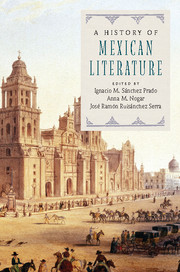Book contents
- Frontmatter
- Contents
- List of contributors
- Introduction
- PART I COLONIAL LITERATURE
- PART II THE NINETEENTH CENTURY
- PART III TWENTIETH AND TWENTY-FIRST CENTURIES
- 15 The Ateneo de la Juventud: The Foundations of Mexican Intellectual Culture
- 16 Regimes of the Avant-garde: Colonialists, Stridentists, Proletarians, Surrealists, Contemporáneos, and Independent Rupture (1920–1950)
- 17 The Institution of Fiction: From Yáñez, Rulfo, and Fuentes to Pitol and Del Paso
- 18 Octavio Paz: Literature, Modernity, Institutions
- 19 Mexican Poetry after the Avant-garde
- 20 Nonfictions: Essay, Criticism, and Chronicle
- 21 Balancing Acts: Twentieth- and Twenty-First-Century Mexican Theater
- 22 Women Writers in the Land of “Virile” Literature
- 23 The Hidden Histories of Gender: LGBTQ Writers and Subjectivities in Mexico
- 24 Mexican Literature in the Neoliberal Era
- PART IV MEXICAN LITERATURE BEYOND BOUNDARIES
- Index
- References
21 - Balancing Acts: Twentieth- and Twenty-First-Century Mexican Theater
from PART III - TWENTIETH AND TWENTY-FIRST CENTURIES
Published online by Cambridge University Press: 05 July 2016
- Frontmatter
- Contents
- List of contributors
- Introduction
- PART I COLONIAL LITERATURE
- PART II THE NINETEENTH CENTURY
- PART III TWENTIETH AND TWENTY-FIRST CENTURIES
- 15 The Ateneo de la Juventud: The Foundations of Mexican Intellectual Culture
- 16 Regimes of the Avant-garde: Colonialists, Stridentists, Proletarians, Surrealists, Contemporáneos, and Independent Rupture (1920–1950)
- 17 The Institution of Fiction: From Yáñez, Rulfo, and Fuentes to Pitol and Del Paso
- 18 Octavio Paz: Literature, Modernity, Institutions
- 19 Mexican Poetry after the Avant-garde
- 20 Nonfictions: Essay, Criticism, and Chronicle
- 21 Balancing Acts: Twentieth- and Twenty-First-Century Mexican Theater
- 22 Women Writers in the Land of “Virile” Literature
- 23 The Hidden Histories of Gender: LGBTQ Writers and Subjectivities in Mexico
- 24 Mexican Literature in the Neoliberal Era
- PART IV MEXICAN LITERATURE BEYOND BOUNDARIES
- Index
- References
Summary
At the beginning of the twentieth century, a writer staged a play in Mexico City. While far from revolutionary, Federico Gamboa's (1864–1939) La venganza de la gleba (1904) brought actors to the stage who, in contrast with much of Mexico City theater of the previous century, represented the underclass – complete with their own Mexican accents, instead of imitating those of the former Crown. One reviewer opined: “Socialist? A bit. Compassionate more than anything” (Reyes de la Maza, 1968: 288). Gamboa's play is a love story too, and thus it represents the balancing act that helps elucidate the trajectory of twentieth and twenty-first century Mexican theater: dramatists continually mine profound dichotomies in Mexican society to present – and, more often than one might think, since theaters in Mexico City and beyond are often filled to capacity – influence the world around them.
Mexican theater is marked by innovations that originate in performances by pre- and post-Columbian indigenous populations, which to this day are active in the production of performances that shape society: literary greats such as the colonial writer Sor Juana Inés de la Cruz (1651–1695); European theater, from religious plays to “classics” to modernism and beyond; and an amalgamated mestizo theater that melds, though rarely in equal measures, seemingly endless contradictions in both form and content – the foreign with the autochthonous, the socially conscious with the literarily inventive, the commercial with the independent, the center with the periphery. Despite the dizzying, bipolar originality of Mexican theater, one constant can be seen both in the plays that attempt (with relatively rare success) to evade Mexico's sociopolitical reality and plays that (more commonly) interrogate Mexico's past and present in order to bridge the gap between order and disorder. This constant is often illuminated through the humor that characterizes much of Mexican life – humor that can be at once gentle and biting, obvious and subtle, but that almost always involves wordplay, making use of and reveling in double entendre, paradoxes, discontinuities, and incoherencies to communicate ideas with astounding clarity.
- Type
- Chapter
- Information
- A History of Mexican Literature , pp. 323 - 337Publisher: Cambridge University PressPrint publication year: 2016



